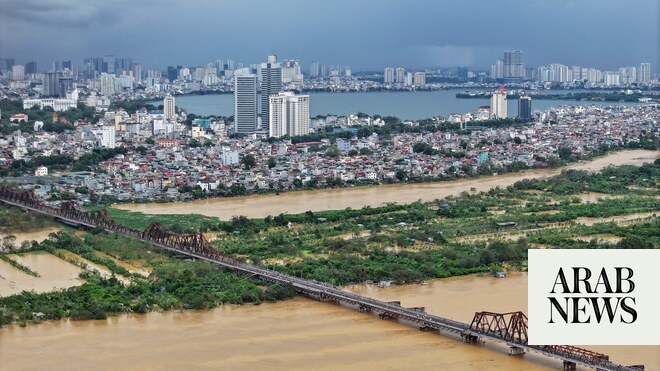Hanoi: Residents of Hanoi waded through deep water on Wednesday as river levels rose to their highest level in 20 years, the death toll from the worst typhoon in decades passed 150, and neighboring countries suffered deadly floods and landslides. they did
Typhoon Yagi hit Vietnam over the weekend, packing winds of more than 149 kilometers per hour and torrential rains that also brought devastating floods to northern Laos, Thailand and Myanmar.
The Red River in Hanoi reached its highest level in 20 years on Wednesday, forcing residents to wade through waist-deep brown water to retrieve belongings from flooded homes.
Others made makeshift boats out of whatever materials they could find.
“It was the worst flood I've ever seen,” said Nguyen Tran Van, 41, who has lived near the Red River in the Vietnamese capital for 15 years.
I didn't think the water would rise so fast. I moved on, for if the water rose a little higher it would have been very difficult for us to get out.
A landslide collapsed into the remote mountain village of Long Nu in Laokai province, turning it into a flat expanse of mud and rock, littered with debris and streams.
State media said at least 30 people were killed in the village and 65 others were still missing.
Villagers laid dead bodies on the ground, some in makeshift coffins, some wrapped in cloth, while police dug through the dirt with picks and shovels in search of more victims.
Vietnamese state media said the death toll from Yagi – the strongest typhoon in northern Vietnam in 30 years – had risen to 155 across the country, with 141 missing.
Reports said it was unclear if the total included victims of Tuesday's landslide, where access was difficult and internet was down.
Mai Van Kim, head of the National Meteorological Administration, told state media that the water level in the Red River in Hanoi had reached its highest level since 2004.
He warned about widespread flooding in the provinces around the capital in the coming days.
Police, soldiers and volunteers helped hundreds of residents along the banks of the swollen Hanoi River to evacuate their homes in the early hours as water levels rose rapidly.
A police official in Hanoi, who spoke on condition of anonymity, said officers were going on foot or by boat to check all the houses along the river.
“All residents must leave,” he said. We bring them to public buildings that have been converted into temporary shelters or they can stay with relatives. “It has been raining a lot and the water is rising rapidly.”
Images on Tuesday showed people trapped on rooftops and victims posting desperate pleas for help on social media, while 59,000 people were forced to evacuate their homes in Yen Bai province.
Sivilai Pankao, deputy prefect of Laos district, said authorities evacuated 300 people from 17 villages in northern Luang Namtha province.
He said: The Laos-China high-speed railway has not been affected by the flood.
In the historic city of Luang Prabang – a World Heritage Site and major tourist destination – houses and shops were flooded, the Lao Post reported.
State media said at least one person had been killed and pictures showed rescuers working in the dark brown waters of the flood.
Thai authorities said four people were killed in the kingdom's northern Chiang Mai and Chiang Rai provinces, and the army was deployed to help some 9,000 flooded families.
In Myanmar, residents and local media said flooding knocked out power and phone lines in the city of Tachilik, in eastern Shan state, where more heavy rain is expected.
In the south, hundreds of residents of Myanmar's border trading hub of Myawaddy fled their homes to take shelter in schools and monasteries on higher ground, a resident of the town, which straddles the border with Thailand, said.
Southeast Asia experiences annual monsoon rains, but man-made climate change is creating more extreme weather patterns that can increase the likelihood of devastating floods.
According to a study published in July, storms in the region are forming closer to the coast, intensifying faster and staying longer because of climate change.
